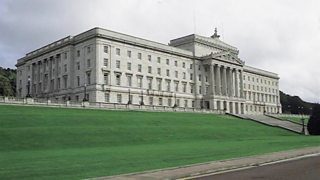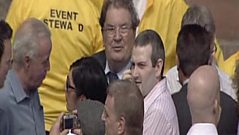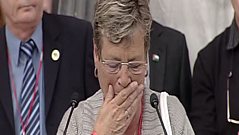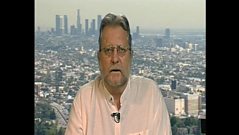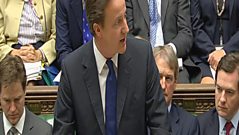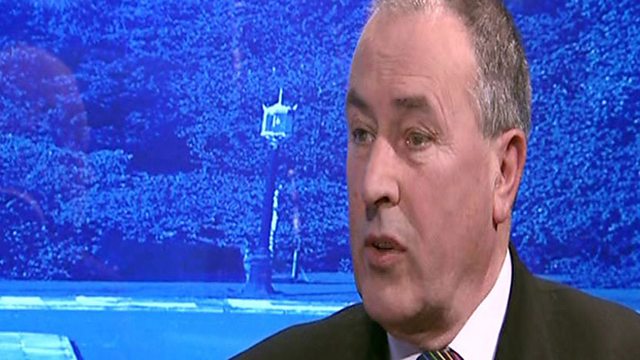
Early political reaction to the Saville report
The Ulster Unionist Party’s Sir Reg Empey, Sinn Fein’s Mitchel McLaughlin and the �鶹��’s Paul McCauley respond to Lord Saville’s report on Bloody Sunday.
In the �鶹��’s Stormont studio Jim Fitzpatrick is joined by Sir Reg Empey (the leader of the Ulster Unionist Party), Sinn Fein’s Mitchel McLaughlin and the former �鶹�� Ireland Correspondent, Denis Murray.
Sir Reg Empey welcomes the fact that the families of the Bloody Sunday victims have had some relief from Lord Saville’s report, he also points out that there are many people watching who are unable to move on with their lives as they have not had the same opportunities to have their innocent victims recognised and remembered. He mentions the killing of two RUC officers (Royal Ulster Constabulary) in Londonderry three days before Bloody Sunday and says no one has been convicted of the killings nor has anyone apologised for the killings. The two officers were: Sergeant Peter Gilgunn and Constable David Montgomery.
Mitchel McLaughlin recognises that the losses of those in the Unionist community will have to be recognised if society is to go through a process of reconciliation. He feels that we couldn’t go in for a countless list of Saville inquiries but we could go for a truth recovery process in which all protagonists would take part. He says that in an earlier discussion in the programme he could see the pain that the Ulster Unionist’s Party’s Arlene Foster was feeling, he knows that she was a victim of an IRA (Irish Republican Army) attack. (An attempt was made on her father’s life by a gunman who called at the family home)
Jim Fitzpatrick then interviews the �鶹��’s Paul McCauley who is in Guildhall Square. Paul attended every day of the inquiry and has a printed version of the principle conclusions. As Paul recaps the conclusions that all the victims of Bloody Sunday were innocent we see footage of Sinn Fein’s Gerry Adams, Martin McGuinness, Conor Murphy and Martina Anderson embracing members of the victims’ families.
Paul McCauley points out that Lord Saville did not entirely believe Martin McGuinness’s account of some of his movements on Bloody Sunday and that Saville concludes he probably had a submachine gun at an early stage in the day; having stated this, Saville could find no activity on the part of Martin McGuinness that would justify the soldiers firing on the marchers.
Paul also recaps Lord Saville’s finding that Colonel Derek Wilford, the Commander of 1 Para, should not have ordered his men into the Bogside. As Paul is speaking we see John Hume mingling with the Sinn Fein leadership and the victims’ families.
Paul acknowledges that Lord Saville’s conclusions could provide a basis for the victims’ families to take civil cases against the soldiers.
CONTEXT
On 30 January 1972 soldiers from the 1st Parachute Regiment killed 13 innocent civil rights demonstrators in Derry.
The period from August 1971 to January 1972 saw a sustained campaign of anti-internment protests. On 22 January, John Hume led an illegal demonstration along Magilligan Strand just outside Londonderry, towards a nearby internment camp. The marchers were confronted by soldiers of the 1st Parachute Regiment who drove them off the beach using baton charges and rubber bullets.
It was these same paratroopers who were sent into Derry eight days later to deal with another banned protest. This march was organised by the Northern Ireland Civil Rights Association (NICRA). Some ten thousand people gathered in the Creggan estate and proceeded towards Guildhall Square in the centre of the city. The paratroopers had sealed off the approaches to the Square and the march organisers, in order to avoid trouble, led most of the demonstrators towards Free Derry Corner in the Bogside.
Groups of local youths (referred to by the security forces as ‘YDHs’ – Young Derry Hooligans) stayed behind at the Army barricades to confront the soldiers. The soldiers were ordered to move in and arrest as many of the rioters as possible. Just after four o'clock, the paratroopers made their move. What took place next was totally unexpected: the paratroopers opened fire on the crowd, killing thirteen men and injuring thirteen others; one of the injured died some time later.
The soldiers claimed that they had been fired on as they moved in to make arrests. As far as the people of the Bogside and further afield were concerned, the Army had summarily executed thirteen unarmed, innocent civilians. The Widgery Tribunal, which had been set up to investigate the circumstances surrounding the killings, later concluded that: ‘At one end of the scale, some soldiers showed a high degree of responsibility; at the other end.... firing bordered on the reckless’.
The Londonderry Coroner, Major Hubert O'Neill, did not share Lord Widgery's conclusion. At the end of the inquest in 1973, which is still seen by nationalists as a cover up for murder, O'Neill said, “It strikes me that the army ran amok that day and they shot without thinking what they were doing… I say it without reservation - it was sheer unadulterated murder”.
The British government later made out-of-court settlements with the bereaved families
In 1998 the Labour government launched an in-depth investigation chaired by Lord Saville of Newdigate. The Saville Inquiry, which was the most expensive investigation of its kind in the United Kingdom, reported in June 2010.
It concluded that none of the dead posed a threat and the actions of the soldiers were totally without justification. The Prime Minister David Cameron apologised on behalf of the nation for the “unjustified and unjustifiable killings”.
Duration:
This clip is from
More clips from Stormont Live Special - The Saville Inquiry Report
-
![]()
Publication of Saville Report
Duration: 11:42
-
![]()
Relatives of Bloody Sunday victims
Duration: 27:09
-
![]()
Interview with Tony Clarke
Duration: 03:41
-
![]()
David Cameron responds to the Saville Report
Duration: 14:46
